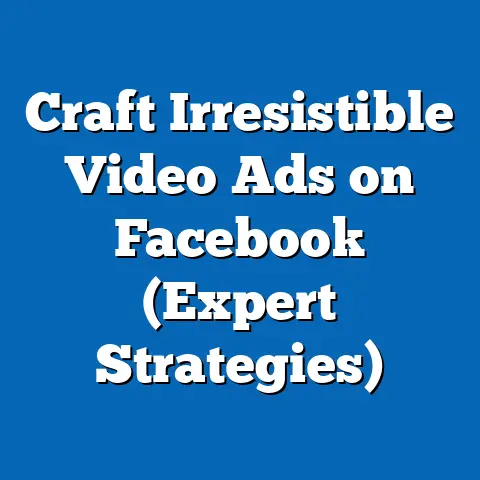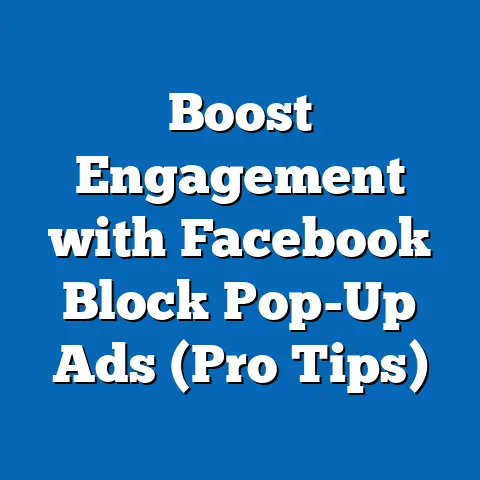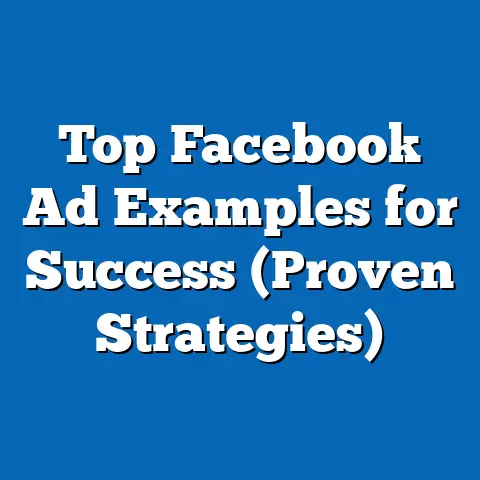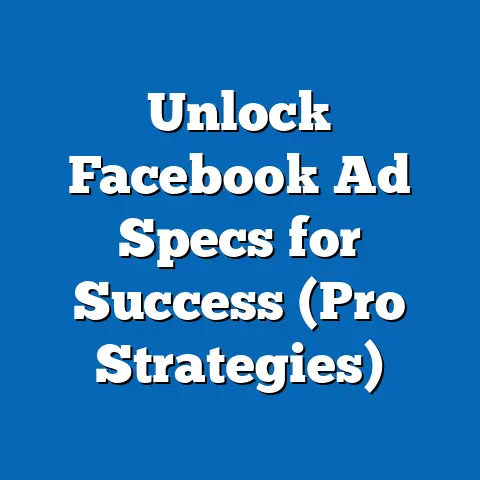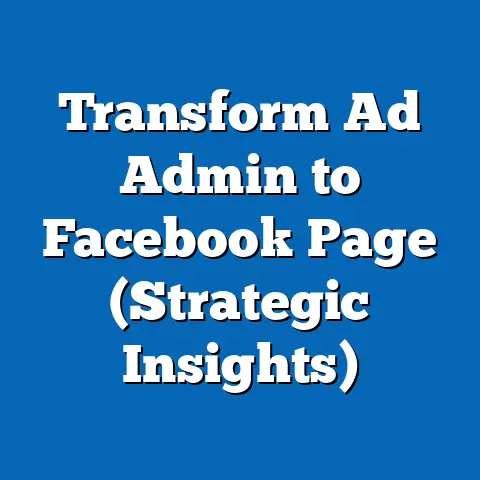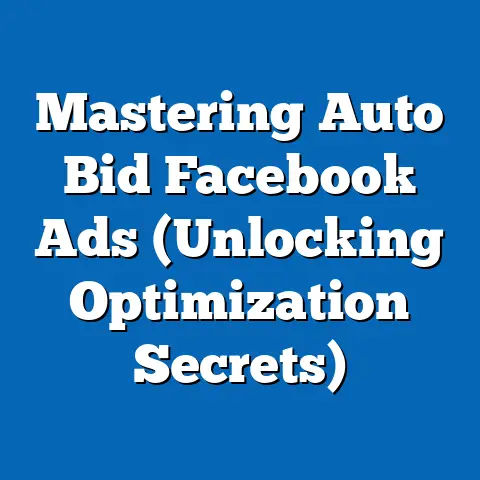Maximizing Reach with Facebook Ads (Essential Media Insights)
Nostalgia. It’s a powerful force, isn’t it? The scent of a particular perfume that instantly transports you back to your grandmother’s kitchen. A song on the radio that floods your mind with memories of a summer long past. As marketers, we often underestimate the sheer power of these emotional connections. But what if I told you that you could harness that power to skyrocket your reach on Facebook?
I’ve seen firsthand how nostalgia can turn a lukewarm campaign into a viral sensation. It’s not just about throwing in a few retro images; it’s about understanding the deep-seated emotional needs and desires of your target audience. Think about the re-release of classic video game consoles – pure nostalgia fueling massive sales. Or consider the revival of vintage fashion trends, driven by a yearning for simpler times.
The beauty of nostalgia is that it transcends age and demographics. While different generations might resonate with different eras, the underlying emotion remains the same: a longing for a cherished past. In this article, I’ll be diving deep into how you can effectively leverage nostalgia in your Facebook ads to maximize your reach, engagement, and ultimately, your ROI. We’ll explore the psychology behind it, the practical steps to crafting compelling ads, and even peek into the future of nostalgia marketing. Get ready to unlock a powerful new dimension in your Facebook advertising strategy!
Section 1: Understanding Facebook Ads
Before we dive headfirst into the wonderful world of nostalgia, let’s establish a solid foundation by understanding the fundamentals of Facebook Ads. Think of Facebook Ads as your digital billboard, strategically placed in front of the people most likely to be interested in what you have to offer. But unlike a static billboard, Facebook Ads are incredibly dynamic and customizable.
What are Facebook Ads?
Facebook Ads are paid messages that businesses can display to Facebook users. These ads appear in various locations, including the news feed, right column, Instagram feed, and even within Messenger. They’re a powerful tool for reaching a massive and highly targeted audience.
In my experience, one of the biggest mistakes I see businesses make is treating Facebook Ads like an afterthought. They throw up a generic ad with a blurry image and wonder why it doesn’t perform. The truth is, Facebook Ads are a sophisticated platform that requires careful planning and execution.
Types of Facebook Ads
Facebook offers a diverse range of ad formats to suit different objectives and creative styles. Here’s a quick rundown of some of the most popular options:
- Image Ads: These are single-image ads that are simple yet effective for conveying a clear message. I’ve found that high-quality, eye-catching images are crucial for grabbing attention in the busy news feed.
- Video Ads: Video ads are incredibly engaging and allow you to tell a more compelling story. Short, attention-grabbing videos often perform best.
- Carousel Ads: These ads allow you to showcase multiple images or videos in a single ad unit. This is great for highlighting different products or features. I’ve used carousel ads to showcase different angles of a product, each highlighting a specific benefit.
- Collection Ads: Designed for mobile shoppers, collection ads feature a main video or image, followed by several product images below. This format provides a seamless shopping experience.
- Instant Experience Ads: Formerly known as Canvas ads, these are full-screen, mobile-optimized ads that provide an immersive experience. They’re perfect for telling a brand story or showcasing a product in detail.
The Power of Targeting
What truly sets Facebook Ads apart is its incredibly granular targeting capabilities. You can target users based on a wide range of factors, including:
- Demographics: Age, gender, location, education, relationship status, and more.
- Interests: Hobbies, interests, pages they’ve liked, and groups they’ve joined.
- Behaviors: Past purchase behavior, online activity, device usage, and more.
- Custom Audiences: You can upload your own customer lists or create audiences based on website visitors or app users. This is incredibly powerful for retargeting.
- Lookalike Audiences: Facebook can create audiences that are similar to your existing customers, expanding your reach to new potential buyers.
I remember one campaign where we used a lookalike audience based on our top-spending customers. The results were phenomenal – we saw a 3x increase in conversion rates compared to our standard targeting.
Facebook by the Numbers
To truly appreciate the potential of Facebook Ads, let’s take a look at some key statistics:
- Facebook has over 2.9 billion monthly active users. That’s a massive audience pool!
- The average Facebook user spends approximately 30 minutes per day on the platform. That’s a significant amount of time to capture their attention.
- Facebook generates over $117 billion in advertising revenue annually. This demonstrates the platform’s effectiveness for businesses.
- Mobile advertising accounts for the vast majority of Facebook’s ad revenue. Mobile optimization is crucial for success.
Key Takeaway: Facebook Ads are a powerful tool for reaching a massive and highly targeted audience. Understanding the different ad formats and targeting capabilities is essential for creating effective campaigns.
Next Steps: Familiarize yourself with the Facebook Ads Manager interface and explore the various targeting options available. Start experimenting with different ad formats to see what works best for your business.
Section 2: The Psychology of Nostalgia in Marketing
Now that we’ve covered the basics of Facebook Ads, let’s delve into the fascinating psychology of nostalgia and its profound impact on consumer behavior. Why does looking back to the past resonate so strongly with so many of us?
What is Nostalgia?
Nostalgia is a sentimental longing or wistful affection for the past, typically for a period or place with happy personal associations. It’s more than just remembering the past; it’s about feeling a connection to it.
As a kid, I remember spending hours playing with my old Lego sets. The feel of those plastic bricks, the endless possibilities they represented – it’s a feeling I still cherish to this day. That’s nostalgia in action.
The Power of Nostalgia
Nostalgia can be a powerful emotion that influences our thoughts, feelings, and behaviors. Here’s why it’s so effective in marketing:
- Creates a Sense of Belonging: Nostalgia can connect us to a shared past, creating a sense of community and belonging. It reminds us of simpler times and shared experiences.
- Provides Comfort and Security: In times of uncertainty or stress, nostalgia can offer a sense of comfort and security. It reminds us of positive memories and feelings.
- Enhances Brand Connection: When brands tap into nostalgia, they can create a deeper emotional connection with consumers. It’s not just about selling a product; it’s about evoking a feeling.
- Drives Purchase Decisions: Nostalgia can influence purchase decisions by triggering positive emotions and associations. We’re more likely to buy something that reminds us of a happy memory.
Case Studies in Nostalgia Marketing
Numerous brands have successfully incorporated nostalgia into their marketing campaigns. Here are a few notable examples:
- Coca-Cola: Coca-Cola is a master of nostalgia marketing. Their classic “Share a Coke” campaign, which featured names on bottles, tapped into the personal connection people have with the brand.
- Nintendo: Nintendo’s re-release of classic consoles like the NES and SNES was a massive success, driven by nostalgia for the golden age of video games.
- Old Spice: Old Spice’s “The Man Your Man Could Smell Like” campaign, while humorous, also evoked a sense of nostalgia for classic masculinity.
I remember seeing the Coca-Cola “Share a Coke” campaign everywhere. It was brilliant because it personalized the brand experience and tapped into that desire for connection.
Who Responds to Nostalgia?
While nostalgia can appeal to a wide range of people, certain demographic segments are particularly responsive:
- Millennials: Millennials are often nostalgic for the 90s and early 2000s, a time when they were growing up.
- Gen X: Gen Xers are nostalgic for the 70s and 80s, a period of significant cultural change.
- Baby Boomers: Baby Boomers are nostalgic for the 50s and 60s, a time of post-war optimism and prosperity.
However, it’s important to avoid stereotypes. Nostalgia is a personal experience, and individual preferences can vary widely. The key is to understand your target audience and identify the specific eras and experiences that resonate with them.
Key Takeaway: Nostalgia is a powerful emotion that can create a sense of belonging, comfort, and connection. Brands that effectively tap into nostalgia can enhance brand connection and drive purchase decisions.
Next Steps: Consider your target audience and identify the eras, trends, and experiences that are likely to evoke nostalgia for them. Research successful nostalgia marketing campaigns and analyze what made them effective.
Now, let’s get down to the nitty-gritty of crafting Facebook ads that will transport your audience back in time and drive engagement.Step-by-Step Guide to Nostalgia-Driven Facebook Ads
Here’s a step-by-step guide to creating Facebook ads that leverage nostalgia effectively:
-
Identify the Target Audience and Their Nostalgic Triggers:
- This is the most crucial step. You need to know who you’re targeting and what specific eras, trends, or experiences will evoke nostalgia for them.
- Consider factors like age, location, interests, and past purchase behavior.
- Conduct market research, surveys, or focus groups to gather insights.
- For example, if you’re targeting millennials, you might focus on 90s pop culture, early internet trends, or classic video games.
-
Develop Compelling Ad Copy that Resonates Emotionally:
-
Your ad copy should be evocative and transportive, painting a vivid picture of the past.
- Use language that is specific to the era you’re targeting.
- Focus on the emotions and feelings associated with those memories.
- Avoid being overly salesy or pushy. The goal is to create a connection, not just to sell a product.
- For example, instead of saying “Buy our new retro-themed product,” try something like “Remember the good old days? Relive those memories with our new collection.”
-
Select Visuals that Evoke Nostalgia:
-
Visuals are key to triggering nostalgia. Choose images, videos, or graphics that are instantly recognizable and associated with the era you’re targeting.
- Consider using vintage photos, retro fonts, and color palettes.
- If you’re using video, incorporate footage from old movies, TV shows, or commercials.
- Ensure that your visuals are high-quality and optimized for Facebook’s ad specifications.
- For example, if you’re targeting Baby Boomers, you might use images of classic cars, drive-in theaters, or iconic musicians from the 50s and 60s.
-
Incorporate Storytelling to Enhance the Emotional Connection:
-
Storytelling is a powerful tool for connecting with your audience on an emotional level.
- Share personal stories or anecdotes that relate to the era you’re targeting.
- Invite your audience to share their own memories and experiences.
- Create a narrative that is authentic and relatable.
- For example, you could share a story about how your product was inspired by a childhood memory or a family tradition.
Identify the Target Audience and Their Nostalgic Triggers:
- This is the most crucial step. You need to know who you’re targeting and what specific eras, trends, or experiences will evoke nostalgia for them.
- Consider factors like age, location, interests, and past purchase behavior.
- Conduct market research, surveys, or focus groups to gather insights.
- For example, if you’re targeting millennials, you might focus on 90s pop culture, early internet trends, or classic video games.
-
Develop Compelling Ad Copy that Resonates Emotionally:
-
Your ad copy should be evocative and transportive, painting a vivid picture of the past.
- Use language that is specific to the era you’re targeting.
- Focus on the emotions and feelings associated with those memories.
- Avoid being overly salesy or pushy. The goal is to create a connection, not just to sell a product.
- For example, instead of saying “Buy our new retro-themed product,” try something like “Remember the good old days? Relive those memories with our new collection.”
-
Select Visuals that Evoke Nostalgia:
-
Visuals are key to triggering nostalgia. Choose images, videos, or graphics that are instantly recognizable and associated with the era you’re targeting.
- Consider using vintage photos, retro fonts, and color palettes.
- If you’re using video, incorporate footage from old movies, TV shows, or commercials.
- Ensure that your visuals are high-quality and optimized for Facebook’s ad specifications.
- For example, if you’re targeting Baby Boomers, you might use images of classic cars, drive-in theaters, or iconic musicians from the 50s and 60s.
-
Incorporate Storytelling to Enhance the Emotional Connection:
-
Storytelling is a powerful tool for connecting with your audience on an emotional level.
- Share personal stories or anecdotes that relate to the era you’re targeting.
- Invite your audience to share their own memories and experiences.
- Create a narrative that is authentic and relatable.
- For example, you could share a story about how your product was inspired by a childhood memory or a family tradition.
Develop Compelling Ad Copy that Resonates Emotionally:
Your ad copy should be evocative and transportive, painting a vivid picture of the past.
Select Visuals that Evoke Nostalgia:
Visuals are key to triggering nostalgia. Choose images, videos, or graphics that are instantly recognizable and associated with the era you’re targeting.
Incorporate Storytelling to Enhance the Emotional Connection:
Storytelling is a powerful tool for connecting with your audience on an emotional level.
I once worked on a campaign for a local bakery that was celebrating its 50th anniversary. We created a series of Facebook ads that featured vintage photos of the bakery and stories from long-time customers. The response was incredible – people shared their own memories of the bakery and expressed their loyalty to the brand.
Ad Formats for Nostalgia-Driven Campaigns
Certain ad formats are particularly well-suited for nostalgia-driven campaigns:
- Video Ads: Video ads are perfect for telling stories and evoking emotions. Use vintage footage, music, or voiceovers to create a nostalgic atmosphere.
- Carousel Ads: Carousel ads allow you to showcase multiple images or videos, highlighting different aspects of the era you’re targeting.
- Collection Ads: Collection ads are great for showcasing a collection of retro-themed products or services.
Example Ad Copy
Here’s an example of ad copy that leverages nostalgia:
Headline: Remember those late-night diner runs?
Body: Relive those memories with our classic burgers and milkshakes. Just like you remember, but even better.
Call to Action: Visit us today!
Key Takeaway: Crafting effective nostalgia-driven Facebook ads requires a deep understanding of your target audience and their nostalgic triggers. Use compelling ad copy, evocative visuals, and storytelling to create an emotional connection.
Next Steps: Brainstorm specific ideas for nostalgia-driven Facebook ads based on your target audience and your product or service. Create a mock-up of your ad and test it with a small group of people to get feedback.
Section 4: Measurement and Analytics
You’ve created your nostalgia-driven Facebook ads, launched your campaign, and now it’s time to measure your results. Tracking the right metrics is crucial for understanding what’s working, what’s not, and how to optimize your campaign for maximum impact.
The Importance of Measurement
Measuring the success of your Facebook ad campaigns is essential for several reasons:
- Determines ROI: It allows you to calculate the return on investment (ROI) of your advertising spend.
- Identifies What Works: It helps you identify which ads, targeting options, and creative elements are performing best.
- Optimizes Performance: It enables you to make data-driven decisions to improve your campaign performance.
- Justifies Budget: It provides evidence to justify your advertising budget and demonstrate the value of your marketing efforts.
I’ve seen businesses waste thousands of dollars on Facebook ads simply because they weren’t tracking the right metrics. Don’t make the same mistake!
Key Performance Indicators (KPIs) for Nostalgia-Based Ads
When measuring the success of nostalgia-based Facebook ads, here are some key performance indicators (KPIs) to track:
- Engagement Rate: This measures how much your audience is interacting with your ad. It includes metrics like likes, comments, shares, and saves. A high engagement rate indicates that your ad is resonating with your target audience.
- Click-Through Rate (CTR): This measures the percentage of people who see your ad and click on it. A high CTR indicates that your ad is compelling and relevant.
- Conversion Rate: This measures the percentage of people who click on your ad and then take a desired action, such as making a purchase or filling out a form. A high conversion rate indicates that your ad is effectively driving conversions.
- Reach: This measures the number of unique people who saw your ad. Reach is important for building brand awareness and expanding your audience.
- Frequency: This measures the average number of times each person saw your ad. Frequency is important to monitor because too much frequency can lead to ad fatigue.
- Cost Per Click (CPC): This measures the cost you pay for each click on your ad. CPC is important for managing your advertising budget.
- Cost Per Conversion (CPC): This measures the cost you pay for each conversion. CPC is important for understanding the efficiency of your advertising spend.
Using Facebook Ads Manager for Analysis
Facebook Ads Manager is your go-to tool for analyzing your ad performance. It provides a wealth of data and insights that you can use to optimize your campaigns. Here’s how to use it effectively:
- Customize Your Columns: Customize the columns in your Ads Manager to display the KPIs that are most important to you.
- Filter and Segment Your Data: Filter and segment your data by different ad sets, demographics, and placements to identify trends and patterns.
- Use the Reporting Tab: Use the Reporting tab to create custom reports that track your key metrics over time.
- Analyze Your Audience Insights: Use the Audience Insights tool to learn more about your target audience and their interests.
I spend hours poring over the data in Facebook Ads Manager. It’s like detective work – you’re looking for clues to understand what’s working and what’s not.
A/B Testing for Optimization
A/B testing is a powerful technique for optimizing your Facebook ad campaigns. It involves creating two versions of your ad with slight variations and then testing them against each other to see which performs better. Here are some elements you can A/B test:
- Headline: Test different headlines to see which ones generate the most clicks.
- Body Copy: Test different body copy to see which ones resonate best with your audience.
- Visuals: Test different images or videos to see which ones are most engaging.
- Call to Action: Test different call-to-action buttons to see which ones drive the most conversions.
- Targeting: Test different targeting options to see which ones reach the most relevant audience.
When A/B testing, only change one element at a time so you can accurately measure the impact of that change.
Key Takeaway: Measuring the success of your Facebook ad campaigns is essential for determining ROI, identifying what works, and optimizing performance. Track key performance indicators (KPIs) and use Facebook Ads Manager to analyze your data.
Next Steps: Familiarize yourself with Facebook Ads Manager and learn how to customize your columns, filter your data, and create custom reports. Start A/B testing different elements of your ads to optimize your campaign performance.
Section 5: Case Studies of Successful Nostalgia-Based Facebook Ads
Let’s take a look at some real-world examples of brands that have successfully incorporated nostalgia into their Facebook advertising strategies. By analyzing these case studies, we can gain valuable insights and learn how to apply similar strategies to our own campaigns.
Case Study 1: Netflix’s “Stranger Things”
Brand: Netflix
Campaign: Promotion of the “Stranger Things” TV series
Strategy: Netflix cleverly leveraged nostalgia for the 1980s to promote their hit TV series “Stranger Things.” The show itself is steeped in 80s pop culture, with references to classic movies, music, and fashion.
Facebook Ad Examples:
- Video Ad: A trailer for the show featuring iconic 80s music and visuals.
- Image Ad: A promotional image of the cast dressed in 80s attire.
- Carousel Ad: A carousel ad showcasing different characters and elements from the show.
Key Elements:
- Authenticity: The show’s creators clearly had a deep understanding and appreciation for 80s pop culture. This authenticity resonated with viewers.
- Visual Appeal: The show’s visuals were carefully crafted to evoke the look and feel of the 80s.
- Emotional Connection: The show tapped into viewers’ nostalgia for their childhood and the simpler times of the 80s.
Measurable Outcomes:
- The show became a massive hit, with millions of viewers worldwide.
- Netflix’s stock price soared after the show’s release.
- The show generated significant buzz on social media.
Lessons Learned:
- Authenticity is key when leveraging nostalgia.
- Visual appeal is crucial for capturing attention.
- Tapping into viewers’ emotions can drive engagement and loyalty.
Case Study 2: Burger King’s Retro Packaging
Brand: Burger King
Campaign: Limited-time retro packaging
Strategy: Burger King brought back its retro packaging from the 1970s and 1980s for a limited time. This campaign was designed to evoke nostalgia among older customers and attract new customers with its retro appeal.
Facebook Ad Examples:
- Image Ad: A photo of the retro packaging.
- Video Ad: A commercial featuring the retro packaging and classic Burger King menu items.
Key Elements:
- Simplicity: The retro packaging was simple and iconic.
- Nostalgia: The packaging evoked memories of Burger King’s past.
- Limited-Time Offer: The limited-time offer created a sense of urgency and scarcity.
Measurable Outcomes:
- The campaign generated significant buzz on social media.
- Burger King saw an increase in sales during the campaign.
- The campaign attracted new customers to Burger King.
Lessons Learned:
- Simplicity can be effective when leveraging nostalgia.
- Limited-time offers can create a sense of urgency.
- Nostalgia can attract both older and new customers.
Case Study 3: Pepsi’s Throwback Cans
Brand: Pepsi
Campaign: Limited-edition throwback cans
Strategy: Pepsi released limited-edition throwback cans featuring its vintage logo and design. This campaign was designed to evoke nostalgia among older customers and generate excitement among younger customers.
Facebook Ad Examples:
- Image Ad: A photo of the throwback can.
- Video Ad: A commercial featuring the throwback can and classic Pepsi slogans.
Key Elements:
- Authenticity: The throwback can was a faithful reproduction of Pepsi’s vintage design.
- Nostalgia: The can evoked memories of Pepsi’s past.
- Limited-Edition: The limited-edition status created a sense of collectibility.
Measurable Outcomes:
- The campaign generated significant buzz on social media.
- Pepsi saw an increase in sales during the campaign.
- The campaign attracted new customers to Pepsi.
Lessons Learned:
- Authenticity is key when reproducing vintage designs.
- Limited-edition status can create a sense of collectibility.
- Nostalgia can generate excitement among both older and younger customers.
I remember seeing the Pepsi throwback cans in stores and feeling a sense of excitement. It was like a little piece of history in my hand.
Key Takeaway: These case studies demonstrate that nostalgia can be a powerful tool for driving engagement, generating buzz, and increasing sales. Authenticity, visual appeal, and emotional connection are key elements of successful nostalgia-based campaigns.
Next Steps: Analyze these case studies in more detail and identify the specific strategies and tactics that made them effective. Consider how you can apply similar strategies to your own Facebook advertising campaigns.
Section 6: Future Trends in Facebook Advertising and Nostalgia
As technology continues to evolve and consumer behaviors shift, the future of Facebook advertising and nostalgia is ripe with exciting possibilities. Let’s explore some potential trends and how you can stay ahead of the curve.
Augmented Reality (AR) and Virtual Reality (VR)
Augmented reality (AR) and virtual reality (VR) have the potential to revolutionize the way we experience nostalgia. Imagine being able to step back in time and experience a historical event or relive a cherished memory in a fully immersive environment.
- AR Ads: AR ads could allow users to overlay vintage images or graphics onto their current surroundings, creating a sense of nostalgia in their everyday lives.
- VR Experiences: VR experiences could transport users to historical locations or recreate iconic moments from the past.
I can envision a VR experience that allows you to walk through a 1950s diner, complete with the sights, sounds, and smells of the era.
Personalized Nostalgia
As Facebook’s targeting capabilities become even more sophisticated, the potential for personalized nostalgia increases. Imagine being able to target users with ads that are tailored to their specific childhood memories or personal experiences.
- Dynamic Creative: Dynamic creative could allow you to automatically generate ads that feature images, videos, and copy that are relevant to each user’s individual interests and preferences.
- Custom Audiences: Custom audiences could be created based on users’ past experiences, allowing you to target them with ads that evoke specific memories.
The Metaverse and Nostalgia
The metaverse, a persistent, shared virtual world, offers a new frontier for nostalgia marketing. Brands could create virtual spaces that are designed to evoke specific eras or memories.
- Virtual Storefronts: Virtual storefronts could be designed to look like classic stores from the past.
- Interactive Experiences: Interactive experiences could allow users to relive iconic moments from pop culture history.
The Enduring Power of Nostalgia
Despite the rapid pace of technological change, the power of nostalgia is likely to endure. As long as humans have memories and emotions, they will continue to be drawn to the past.
- Timeless Appeal: Nostalgia is a timeless emotion that transcends generations.
- Emotional Connection: Nostalgia creates a deep emotional connection with consumers.
- Brand Loyalty: Nostalgia can foster brand loyalty and drive repeat purchases.
I believe that nostalgia will continue to be a valuable tool for marketers for years to come. It’s a way to connect with consumers on a human level and create lasting memories.
Key Takeaway: The future of Facebook advertising and nostalgia is ripe with exciting possibilities. Augmented reality (AR), virtual reality (VR), personalized nostalgia, and the metaverse offer new ways to engage consumers and evoke powerful emotions.
Next Steps: Stay up-to-date on the latest trends in Facebook advertising and technology. Experiment with new ad formats and targeting options to see how you can leverage nostalgia in innovative ways.
Conclusion
We’ve covered a lot of ground in this article, from the fundamentals of Facebook Ads to the psychology of nostalgia and the future trends in advertising. The key takeaway is that nostalgia is a powerful tool that can be used to maximize your reach, engagement, and ROI on Facebook.
By understanding your target audience, crafting compelling ad copy, selecting evocative visuals, and measuring your results, you can create Facebook ads that transport your audience back in time and drive meaningful connections.
Don’t be afraid to experiment with different strategies and tactics. The world of Facebook advertising is constantly evolving, so it’s important to stay curious and keep learning.
I encourage you to consider incorporating nostalgic elements into your own advertising strategies. It’s a way to stand out from the crowd, connect with consumers on a human level, and create lasting memories.
So go ahead, tap into the power of nostalgia and watch your Facebook ad campaigns soar!

